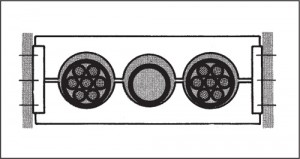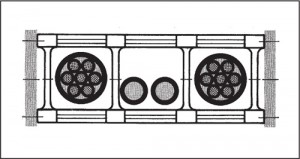
Track cables have an important task of supplying control and power to machines in various high-flex cable applications. The cables must flex simultaneously and stay synchronized to operate properly. Correct installation and placement of the cables in the track helps ensure the cables’ functionality and service life (measured in cycles).
The following guidelines should be observed when installing cables in a track.
- When flat and round cables are installed in the same track, they should be placed loosely next to one another with guide stays separating them. Try to avoid placing round cables of different sizes next to each other. Due to space constraints, when cables are installed above one another frame dividers are used.
- Cables must be installed with guide stays, dividers or in separate hole stays so they can move freely within the track guides. The space for the cables in the guide stays should be at least 10% of the cables outer diameter (O.D.).
- Always ensure that the cables follow the track’s motion without any constraints.
- When cables are installed in layers within the track, it’s important to check that the cables don’t block each other when the track alters direction.

Cables must be reeled out in a downward motion from the reel or drum. - Cables should lay flat when installed in the track to avoid twisting and eventual corkscrewing when in operation. Cables must be reeled out in a downward motion from the reel or drum. The cables should not be raised up in a twisting or looping motion when unreeling. Before installation the cables should be laid out flat in a straight line to remove any twists. Allow at least 10% of extra cable length than required to avoid twists when installing the cable in the track.

Flexible conduits should be used when an O.D. of less than 10 mm can not be achieved. - When it’s not possible to install cables as described in point 1, with an O.D. less than 10 mm, it’s recommended that flexible conduit be used. The cables are loosely installed in the conduit before being integrated into the track. The cross section of the conduit must be much larger than the sum of the diameters of the installed cables.
- When high-pressure or hydraulic hoses are used in a cable track, the hoses should be able to expand and contract without interrupting the track’s motion or operation.

Hydraulic hoses should be able to expand and contract without interrupting the track’s motion or operation. - To maintain balance in a cable track, it is necessary to keep the weight of the cables divided evenly. Install the heavier cables towards the outer edges of the track and the lighter cables in the middle. All cables must be attached securely at each end of the track and checked to verify that the outer jacket is not rubbing against the cable track. As a general rule, allow a distance of 20 to 30 times the cable’s O.D. from where the cable is attached to where the cable bends in the track. Don’t tighten the clamps holding the cable to the track too tight or they may crush the conductors. However, the clamps should be tight enough so that the cable doesn’t shift when the track is in operation.

Keep the weight of the cables divided evenly by installing heavier cables towards the outer edges of the track and the lighter cables in the middle.
As a final note, it is also recommended to not install cables with more than 25 conductors in a cable track. It’s better to split the number of conductors over several cables.
Contributed by Kevin Siegel, Communications Manager
Helukabel USA
www.helukabel.com



Do you know of any standard regulation which specifies the physical characteristics of a flexible installation, in terms of displacements, bending radius etc…
For instance, would you consider a power supply cable to a vibrator with few millimeters amplitude a “flexible” or “fixed” installation ?
Thanks for your prompt reply